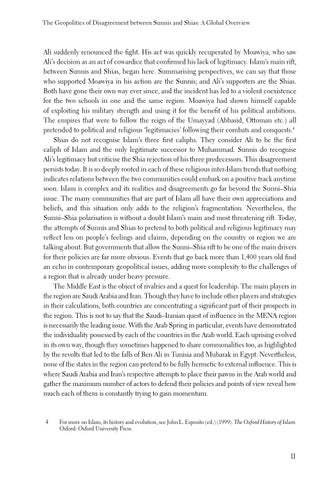The Geopolitics of Disagreement between Sunnis and Shias: A Global Overview
Ali suddenly renounced the fight. His act was quickly recuperated by Moawiya, who saw Ali’s decision as an act of cowardice that confirmed his lack of legitimacy. Islam’s main rift, between Sunnis and Shias, began here. Summarising perspectives, we can say that those who supported Moawiya in his action are the Sunnis; and Ali’s supporters are the Shias. Both have gone their own way ever since, and the incident has led to a violent coexistence for the two schools in one and the same region. Moawiya had shown himself capable of exploiting his military strength and using it for the benefit of his political ambitions. The empires that were to follow the reign of the Umayyad (Abbasid, Ottoman etc.) all pretended to political and religious ‘legitimacies’ following their combats and conquests.4 Shias do not recognise Islam’s three first caliphs. They consider Ali to be the first caliph of Islam and the only legitimate successor to Muhammad. Sunnis do recognise Ali’s legitimacy but criticise the Shia rejection of his three predecessors. This disagreement persists today. It is so deeply rooted in each of these religious inter-Islam trends that nothing indicates relations between the two communities could embark on a positive track anytime soon. Islam is complex and its realities and disagreements go far beyond the Sunni–Shia issue. The many communities that are part of Islam all have their own appreciations and beliefs, and this situation only adds to the religion’s fragmentation. Nevertheless, the Sunni–Shia polarisation is without a doubt Islam’s main and most threatening rift. Today, the attempts of Sunnis and Shias to pretend to both political and religious legitimacy may reflect less on people’s feelings and claims, depending on the country or region we are talking about. But governments that allow the Sunni–Shia rift to be one of the main drivers for their policies are far more obvious. Events that go back more than 1,400 years old find an echo in contemporary geopolitical issues, adding more complexity to the challenges of a region that is already under heavy pressure. The Middle East is the object of rivalries and a quest for leadership. The main players in the region are Saudi Arabia and Iran. Though they have to include other players and strategies in their calculations, both countries are concentrating a significant part of their prospects in the region. This is not to say that the Saudi–Iranian quest of influence in the MENA region is necessarily the leading issue. With the Arab Spring in particular, events have demonstrated the individuality possessed by each of the countries in the Arab world. Each uprising evolved in its own way, though they sometimes happened to share commonalities too, as highlighted by the revolts that led to the falls of Ben Ali in Tunisia and Mubarak in Egypt. Nevertheless, none of the states in the region can pretend to be fully hermetic to external influence. This is where Saudi Arabia and Iran’s respective attempts to place their pawns in the Arab world and gather the maximum number of actors to defend their policies and points of view reveal how much each of them is constantly trying to gain momentum.
4
For more on Islam, its history and evolution, see John L. Esposito (ed.) (1999). The Oxford History of Islam. Oxford: Oxford University Press.
11
